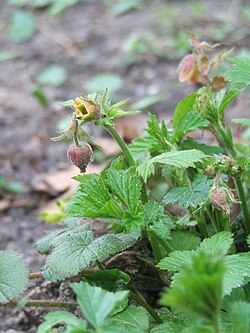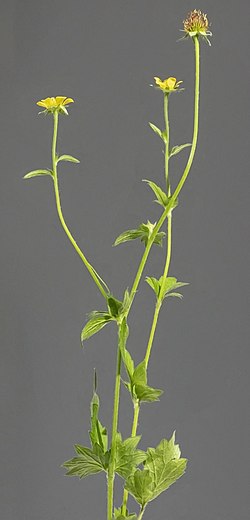Species
A
| Species & Synonyms | Common Names | Native Range | Illustration |
|---|---|---|---|
Geum adnatum Wall. 1829 [1]
|
| ||
| Geum aequilobatum K.M.Purohit & Panigrahi 1979 [2] | |||
| Geum agrimonioides Pursh 1814 |
|  | |
| Geum agrimonioides M.Bieb. ex Spreng. 1825 [8] | |||
Geum agrimonioides C.A.Mey. 1846
| |||
| Geum albarracense Pau ex Merino 1904 [10] | |||
Geum albarracinensePau 1887
| |||
Geum album J.F.Gmel. 1791
| |||
Geum album var. flavum (Porter) 1889
| |||
| Geum aleppicum Jacq. 1786 |
|  | |
| Geum aleppicum var. decurrens(Rydb.) W.A.Weber 1979 | |||
| Geum andicola Reiche 1898 | |||
| Geum aurantiacum Fr. ex Scheutz 1870 |
B
| Species & Synonyms | Common Names | Native Range | Illustration |
|---|---|---|---|
| Geum boliviense Focke 1906 | Chuquisaca, Bolivia [16] | ||
Geum borisiihort. 1996
notGeum × borisiiKellerer ex Sünd. [17] |
|  | |
| Geum × borisiiKellerer ex Sünd. notGeum borisiihort. 1996 [18] | |||
| Geum bulgaricum Pancic |
|
|  |
C
| Species & Synonyms | Common Names | Native Range | Illustration |
|---|---|---|---|
| Geum calthifolium Menzies ex Sm. |
|
| |
Geum calthifolium var. nipponicum(F. Bolle) Ohwi
|  | ||
Geum campanulatum(Greene) G.N. Jones
|
| ||
Geum camporumRydberg 1913
| |||
| Geum canadense Jacq. |
|  | |
| Geum canadense Jacq. var. camporum (Rydberg) Fernald & Weath. 1922
|
| ||
| Geum canadense Jacq. var. texanum Fernald & Weath. |
| ||
Geum canescens(Greene) Munz 1958
| |||
| Geum capense Thunb. | |||
| Geum cercocarpoides DC. ex Ser. | |||
| Geum chilenseBalb. ex Lindl. | Chile | ||
Geum chiloenseBalb. ex Ser. 1825
| Chile |  | |
Geum ciliatumPursh 1814
| |||
| Geum ciliatum var. griseum (Greene) Kearney & Peebles | |||
Geum coccineumLindl. 1827
not Geum coccineum Sm. 1809 | Chile [23] |  | |
Geum coccineum Sm. 1809
notGeum coccineumLindl. 1827 |
|  | |
Geum cockaynei (F.Bolle) Molloy & C.J.Webb, 1994
|
D
| Species & Synonyms | Common Names | Native Range | Illustration |
|---|---|---|---|
Geum decurrensRydberg 1913
| |||
Geum divergens Cheeseman 1916
| |||
| Geum donianum (Tratt.) Weakley & Gandhi | |||
| Geum dryadoides DC. ex Ser. |
E
| Species & Synonyms | Common Names | Native Range | Illustration |
|---|---|---|---|
Geum elatumWall. ex G. Don 1832
|
| ||
Geum elatum var. humile(Royle) Hook. f.
| |||
Geum elatum var. humileFranch.
| |||
Geum elatum var. leiocarpumW.E. Evans 1923
| |||
| Geum × erectum Moench |
F
| Species & Synonyms | Common Names | Native Range | Illustration |
|---|---|---|---|
| Geum fauriei H. Lév. | |||
| Geum flavum (Porter) E.P. Bicknell | |||
| Geum fragarioides (Michx.) Smedmark | |||
| Geum franckii Steud. 1840 [28] [29] |
G
| Species & Synonyms | Common Names | Native Range | Illustration |
|---|---|---|---|
| Geum geniculatum Michx. |
| ||
| Geum glabricaule Juz. | |||
Geum glacialeAdams ex Fisch. & C.A.Meyer 1809
|
|
|  |
| Geum gracilipes (Piper) M.Peck |
H
| Species & Synonyms | Common Names | Native Range | Illustration |
|---|---|---|---|
Geum heterocarpumBoiss. 1838
| |||
| Geum hirsutum Muhl. ex Link | |||
| Geum hirsutum Muhl. 1813 | |||
Geum hispidum Fr. 1817 [33]
|
|
| |
| Geum hispidum ssp. albarracinense(J.F.Gmel.) Mateo | |||
| Geum hispidum ssp. albarracinense(Pau) Mateo [35] |
I
| Species & Synonyms | Common Names | Native Range | Illustration |
|---|---|---|---|
| Geum idahoense (Piper) Smedmark | |||
Geum intermediumBesser ex M.Bieb. 1808
|  | ||
Geum involucratum Jussieu 1768
|
J
| Species & Synonyms | Common Names | Native Range | Illustration |
|---|---|---|---|
| Geum japonicum Thunb. | |||
Geum japonicum var. faurieiKudo
| |||
Geum japonicum var. sachalinenseKoidz.
|
L
| Species & Synonyms | Common Names | Native Range | Illustration |
|---|---|---|---|
| Geum laciniatum Murray |
|
|  |
| Geum latilobum Somm. & Levier 1893 [39] | |||
| Geum lechlerianum Schltdl. | |||
| Geum leiospermum Petrie | |||
| Geum lobatum (Baldwin) Smedmark |
M
| Species & Synonyms | Common Names | Native Range | Illustration |
|---|---|---|---|
Geum × macranthum (Kearney ex Rydberg) S.L.Welsh 1968
| |||
| Geum macrophyllum Willd. 1809 |
|
|  |
Geum macrophyllum var. perincisum(Rydberg) Raup 1931
| |||
Geum macrophyllum var. sachalinense(Koidz.) H. Hara
|
| ||
Geum macrosepalumLudlow 1976
| |||
Geum magellanicumComm. ex Pers.
| |||
| Geum × meinshausenii Gams. | |||
| Geum mexicanum Rydb. | |||
| Geum meyerianum Rydb. 1913 [43] | |||
| Geum microphyllum Gasp. ex Ten. | |||
| Geum molle Vis. & Pancic | Southeastern Europe [44] | ||
Geum montanumL. 1753
|
|  |
O
| Species & Synonyms | Common Names | Native Range | Illustration |
|---|---|---|---|
Geum oligocarpumJ.Krause
|
| ||
| Geum oregonense (Scheutz) Rydberg |
P
| Species & Synonyms | Common Names | Native Range | Illustration |
|---|---|---|---|
Geum parviflorumComm. ex Sm.
| |||
| Geum peckii Pursh |
|
| |
| Geum pentapetalum (L.) Makino |
|  | |
| Geum pentaphyllum Makino | |||
Geum perincisumRydberg 1913
| |||
| Geum peruvianum Focke 1906 |
| ||
Geum potaniniiJuz. 1941
|
|  | |
| Geum potentilloides Aiton | |||
| Geum pulchrum Fernald | |||
| Geum pusillum | |||
| Geum pyrenaicum Mill. |
|  |
Q
| Species & Synonyms | Common Names | Native Range | Illustration |
|---|---|---|---|
| Geum quellyon Sweet 1829 |
|
|  |
R
| Species & Synonyms | Common Names | Native Range | Illustration |
|---|---|---|---|
Geum radiatum Michx. 1803
|
|  | |
| Geum reptans L. 1753 |
| Europe |  |
| Geum rivale L. |
|  | |
Geum rivale ssp. urbanumÁ. Löve & D. Löve
|  | ||
Geum rossii(R. Br.) Ser. 1825
|
| ||
| Geum rossii var. depressum(Greene) C.L. Hitchc. |
| ||
| Geum rossii var. turbinatum(Rydberg) C.L. Hitchc. |
|
| |
Geum rotundifolium(L.) Moench 1794
|
|
|  |
S
| Species & Synonyms | Common Names | Native Range | Illustration |
|---|---|---|---|
| Geum schofieldii Calder & Roy L. Taylor 1965 [56] | |||
| Geum scopulorum Greene 1900 [57] | Colorado [58] | ||
Geum sericeumGreene 1897
| |||
| Geum × spuriumFisch. & C.A.Meyer | |||
Geum strictumAiton 1789
| |||
Geum strictum var. bipinnatumBatalin 1893
| Europe | ||
| Geum strictum var. decurrens (Rydberg) Kearney & Peebles 1939
| |||
Geum sylvaticum Pourr. 1788
|
T
| Species & Synonyms | Common Names | Native Range | Illustration |
|---|---|---|---|
| Geum triflorum Pursh 1813 |
|  | |
Geum triflorum var. campanulatum(Greene) C.L.Hitchc. 1961
| |||
| Geum triflorum var. canescens(Greene) Kartesz & Gandhi | |||
| Geum triflorum var. ciliatum(Pursh) Fassett | |||
Geum turbinatumRydberg 1897
|
U
| Species & Synonyms | Common Names | Native Range | Illustration |
|---|---|---|---|
Geum umbrosum(L.) Moench 1794
|
|  | |
| Geum uniflorum Buch | |||
| Geum urbanum L. |
|  | |
Geum urbanum ssp. oregonenseScheutz 1870
|
V
| Species & Synonyms | Common Names | Native Range | Illustration |
|---|---|---|---|
Geum vernum (Raf.) Torr. & A. Gray 1840
|
|
| |
Geum vidaliiFranch. & Sav.
|
|  | |
Geum virginianum L. 1753
|
|
|